Color and shade combinations
It is known that by selecting color combinations you can correct the defects of a room, for example, visually raise the ceiling, “push apart” the walls, create a feeling of spaciousness or, conversely, make the room smaller, add warmth or coolness. In addition, some combinations can have a beneficial effect on the nervous system, calm, harmonize, while others have an exciting effect. All this should be taken into account when choosing a color for the bedroom.
First of all, you need to decide whether to use warm or cold colors.
- Warm colors include the part of the spectrum from red to yellow with all intermediate shades – they are usually used in rooms with windows facing north and northeast.
- Cold colors are the opposite part of the spectrum, from blue to violet, they are used in rooms with windows facing south and southwest.
Complex colors such as green and violet can be considered both cold and warm, depending on the additional tones included in their composition. Blue-green and blue-violet are cold colors, but yellow-green and red-violet are warm. Black, white and grey are considered neutral and do not carry either a “warm” or “cold” component.
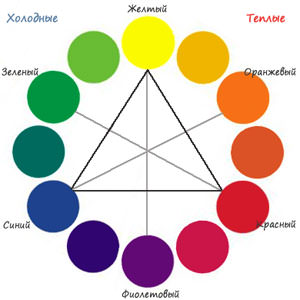

Warm colors have the ability to visually reduce the room, while cold colors, on the contrary, expand it a little. Designers use this when decorating interiors, bringing certain details closer or further away in order to create the maximum decorative effect.
For example, a suitable color for a small bedroom is white and blue. White furniture, which can have contrasting blue inserts, will look good against the background of blue walls. In this case, the bed linen can also be white – this will lighten the interior and visually enlarge the room.
Color harmony
In design, there is such a concept as color harmony. Color by itself and the same color next to another color can look different. In some combinations it will be expressive, and in others – faded. A combination of colors is considered harmonious if each looks most impressive. Color harmony can be built on the principle of nuance or contrast.
Nuance. Harmony based on the nuances of one color is achieved by using close colors or shades of the same color. Usually these are soft, pastel colors. If one color is used, then surfaces with different saturations are combined. For example, the surface of the walls is light beige, and the furniture is dark brown. Usually, nuanced harmony is used in small rooms.
Contrast. You can choose a color for the bedroom based on the principles of contrast harmony. Contrasting colors are combined, no more than three in one room, so as not to create excessive stress on the eyes and not to tire the nervous system. As a rule, two contrasting colors are used – as the main and additional, with the possible addition of a third as an accent. As a primary-additional pair, you can use, for example, the following:
- blue – orange
- blue – yellow
- white – black
You can take both these colors themselves and their shades.
Tip: When choosing color combinations, you can use pantone fans with samples of color shades, which are available in every store selling paints, as well as in designers’ workshops. They make it easy to determine which shades will go well with each other, and which ones should be avoided. For the same purposes, you can use computer programs developed for designers and artists.
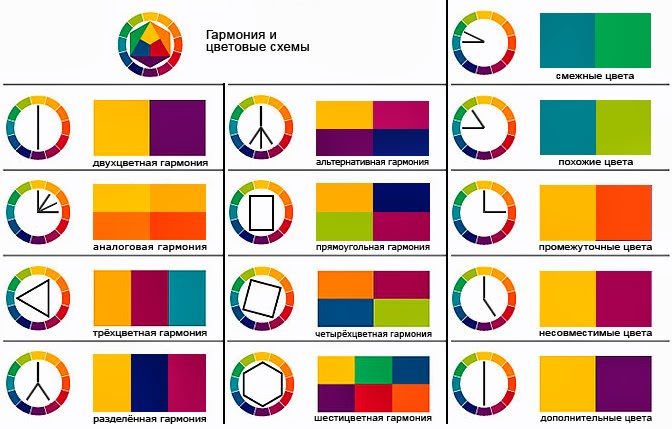

Feng Shui
Each of the world’s cultures has its own traditions of decorating living space, aimed at creating maximum comfort and convenience. Using such traditions can help create an atmosphere that will be most favorable for well-being. In recent decades, the Japanese teaching on interior design – Feng Shui – has been gaining popularity. It takes into account all the nuances – both the arrangement of objects on the cardinal directions, and their color.
The color scheme for the bedroom in the teachings of Feng Shui has its own characteristics.
- A bedroom facing the East and South-East should be maintained in a combination of green and brown colors.
- A bedroom with windows facing the South- or North-West is painted in brown and dark yellow tones.
- Southern windows in the bedroom require choosing red or its shades as the main color.
- A bedroom with windows facing the North is painted in shades of blue.
- If the windows face the West or North-West, the bedroom is painted white.


The influence of color
The choice of color for the bedroom is significantly influenced by its effect on the human nervous system, so this issue must be considered in detail.
- Red
This is a very energetic color, it is associated with the lower, physical chakra, responsible for procreation. It is associated with sexual activity and promotes its manifestations. Therefore, it is necessary to use red in the bedroom very moderately, a large amount of it can cause irritation and fatigue.
The predominance of red in the room can raise blood pressure, increase breathing and heart rate. Red in the bedroom is suitable for activating and maintaining the passion of spouses, but there should not be too much of it, it is better to use calm red shades.

- Orange
A more suitable color for the bedroom is orange. It is a warm color that promotes relaxation, especially if it is diluted with white. Orange is the color of the second chakra, associated with pleasure. The most pleasant for the eyes and nervous system is the peach shade.
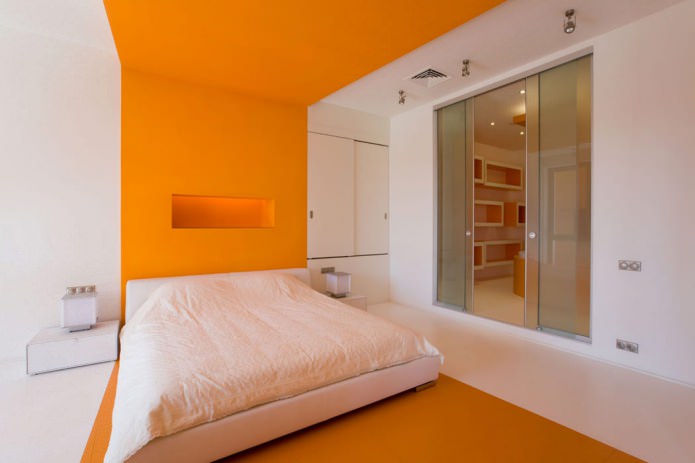
- Yellow
The color of the third chakra, responsible for self-respect and self-awareness in society. A warm, clear color that helps harmonize the nervous system. It has a slight stimulating effect.
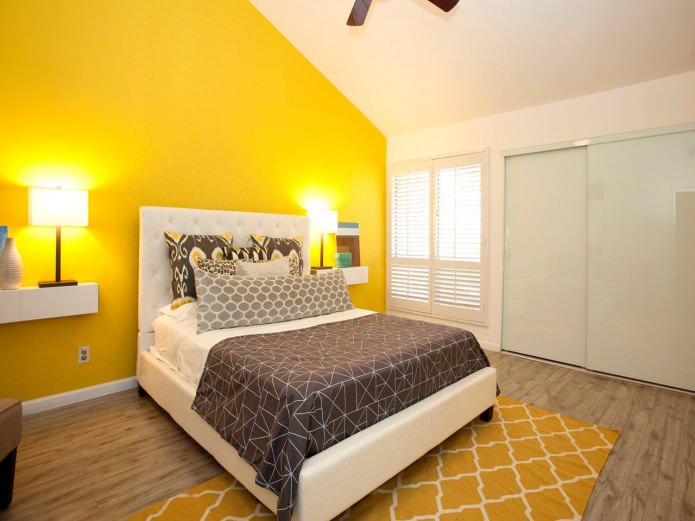
- Green
The color of the heart chakra, associated with tenderness, love, and maternal warmth. This is the color that is most beneficial for the eyes, helping to reduce their fatigue. The nervous system calms down, blood pressure decreases, and the heart rate decreases.
Green is considered one of the most favorable colors for rest and relaxation, and the best choice would be natural, soft shades: olive, green-gray, swamp. Too much green can depress nervous activity, so it must be diluted with other tones.
- Blue and light blue
If you doubt whether you can choose the right color for the bedroom, opt for light blue or light blue, the colors of the fifth and sixth chakras, responsible for spirituality. These shades are the best option – the bedroom creates a feeling of peace, serenity, spaciousness, coolness.
The color of the sky and water is natural, has a positive effect on the mental state and is suitable for interiors of any style. Keep in mind that the blue bedroom should have good lighting, it is also desirable that it faces south. White furniture will help to give the interior lightness and airiness.
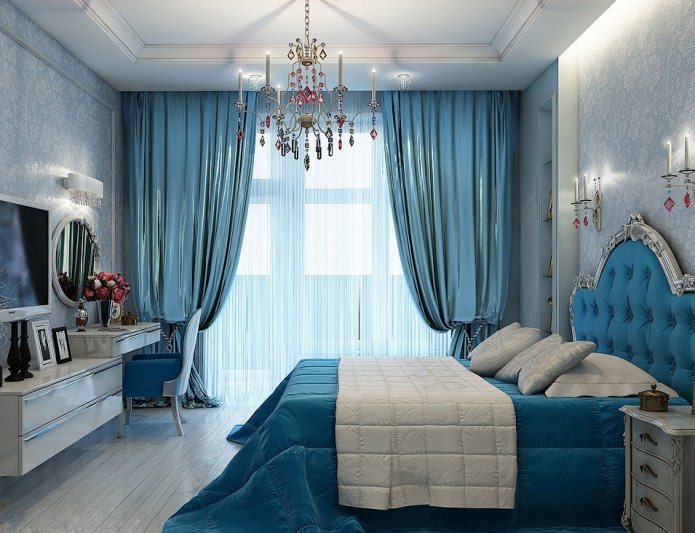
- Purple
The seventh, upper chakra is responsible for the connection with the divine principle, and has a purple color. This is a complex color that requires caution in use. Especially delicate should be handled with dark purple, which can depress the nervous system. At the same time, light, bleached tones will help to create a sublime, slightly mystical atmosphere in the bedroom, and the combination with white will help to visually increase its volume.
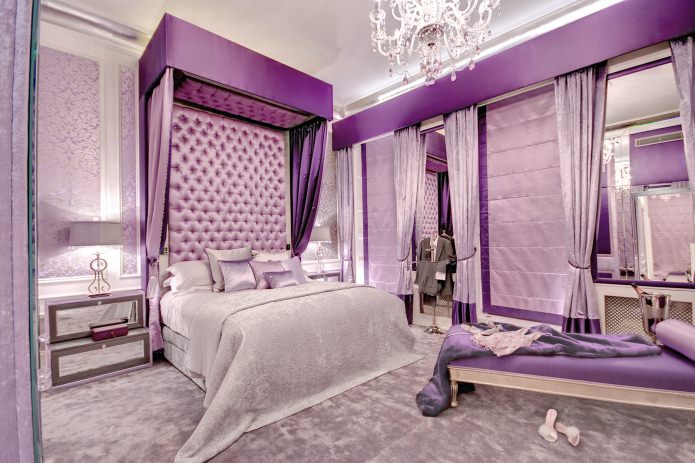
- White
Traditionally, this is the color of purity, infinity, innocence. It has absorbed the entire palette of colors, and has a refreshing effect on the nervous system. White helps to visually enlarge the room, create a feeling of lightness and airiness.
When choosing a color scheme for a bedroom, it is worth stopping at white if the room is small. But you need to think about what shade of color to use. White can be cold or warm. The first option is suitable for bedrooms with southern windows, the second – with northern ones.
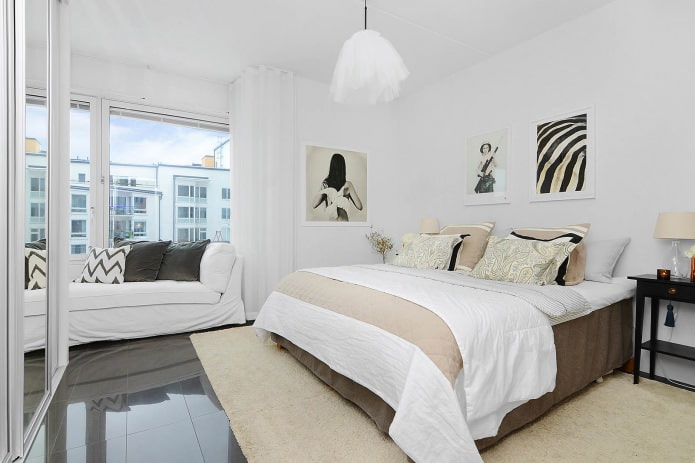
- Brown and beige
Natural shades of brown, including beige and sand, allow you to create a calm atmosphere close to nature. Light beige tones are combined with any others, and can be a good background for both white and dark brown furniture. Brown shades evoke a feeling of security, reliability, solidity. Too dark shades of brown can depress the psyche, so they need to be complemented with light shades.
Beige is a great choice of color for the bedroom, it will give comfort and peace. Complemented with a yellow-brown or gray-brown tone, beige will look very elegant. It can also be combined with other colors of your choice. The color of wenge wood can also be attributed to this group of colors – this is a very dark brown shade of African wood, sometimes almost black. Often, bedroom furniture is made of wenge wood, which looks very advantageous against a beige background.
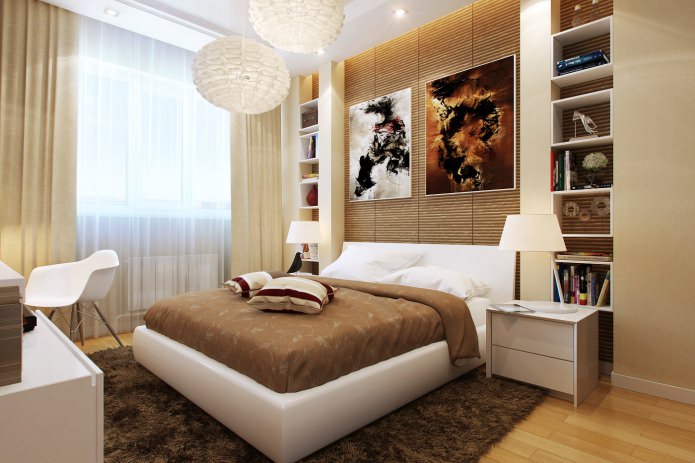
- Gray
Contrary to popular belief, gray is also a suitable color for the bedroom. It is absolutely neutral, which allows you to combine it with any other colors and shades.
Adding a white or black tone changes the saturation of gray, so that even a monochrome bedroom will not seem boring, and, in addition, this provides ample opportunities for visually correcting the defects of the room – those parts of the walls or ceiling that need to be moved away are painted light gray, and those that need to be brought closer – dark.
By adding colored accessories, you can very quickly and inexpensively change the mood of a gray bedroom, and even its temperature: warm tones will bring a feeling of warmth, cold ones – coolness.
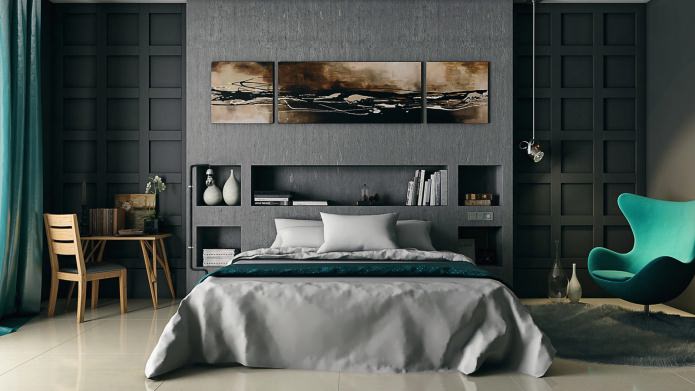
Recommendations for creating a color scheme bedroom solutions
When choosing the colors that you will use, you need to imagine the interior as a whole, and how this particular color fits into it.
- Furniture, finishing materials, textiles, decorative elements – the colors of all objects in the room should be harmoniously combined.
- Neutral tones of furniture and accessories will simplify the creation of a harmonious interior.
- It is recommended to choose a color for the bedroom from a natural palette of colors – green, beige, brown, orange. This will help to create a calm atmosphere conducive to relaxation.
- In small rooms, use light colors as the main ones, in large ones – more saturated, dark ones. To “raise” low ceilings, use a pattern of vertical stripes on the wallpaper.
- The color of the walls depends not only on the chosen tone, but also on the texture of the surface to which it is applied. Sometimes it is enough to change the texture to get the desired shade.
If you have difficulty choosing a color scheme for the bedroom, contact specialist designers who will help you create a comfortable and elegant interior.
Now reading:
- Design 32 sq. m: 4 stylish projects and key design nuances (26 photos)
- Selecting the width of a roller blind and ways to shorten it yourself.
- Making baskets with crochet: diagrams, images and video tutorials.
- Charming Forest Homes (31 Photos) – 8 Ideas for Nature Enthusiasts
- Fence made of corrugated sheet: inspiration and examples of stylish design